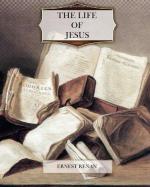[Footnote 5: Mark vi. 5; cf. Matt. xii. 58; Luke iv. 23.]
[Footnote 6: Matt. xiii. 57; Mark vi. 4; John vii. 3, and following.]
[Footnote 7: Luke iv. 29. Probably the rock referred to here is the peak which is very near Nazareth, above the present church of the Maronites, and not the pretended Mount of Precipitation, at an hour’s journey from Nazareth. See Robinson, ii. 335, and following.]
This check far from discouraged him. He returned to Capernaum,[1] where he met with a much more favorable reception, and from thence he organized a series of missions among the small surrounding towns. The people of this beautiful and fertile country were scarcely ever assembled except on Saturday. This was the day which he chose for his teaching. At that time each town had its synagogue, or place of meeting. This was a rectangular room, rather small, with a portico, decorated in the Greek style. The Jews not having any architecture of their own, never cared to give these edifices an original style. The remains of many ancient synagogues still exist in Galilee.[2] They are all constructed of large and good materials; but their style is somewhat paltry, in consequence of the profusion of floral ornaments, foliage, and twisted work, which characterize the Jewish buildings.[3] In the interior there were seats, a chair for public reading, and a closet to contain the sacred rolls.[4] These edifices, which had nothing of the character of a temple, were the centre of the whole Jewish life. There the people assembled on the Sabbath for prayer, and reading of the law and the prophets. As Judaism, except in Jerusalem, had, properly speaking, no clergy, the first comer stood up, gave the lessons of the day (parasha and haphtara), and added thereto a midrash, or entirely personal commentary, in which he expressed his own ideas.[5] This was the origin of the “homily,” the finished model of which we find in the small treatises of Philo. The audience had the right of making objections and putting questions to the reader; so that the meeting soon degenerated into a kind of free assembly. It had a president,[6] “elders,"[7] a hazzan, i.e., a recognized reader, or apparitor,[8] deputies,[9] who were secretaries or messengers, and conducted the correspondence between one synagogue and another, a shammash, or sacristan.[10] The synagogues were thus really little independent republics, having an extensive jurisdiction. Like all municipal corporations, up to an advanced period of the Roman empire, they issued honorary decrees,[11] voted resolutions, which had the force of law for the community, and ordained corporal punishments, of which the hazzan was the ordinary executor.[12]
[Footnote 1: Matt. iv. 13; Luke iv. 31.]
[Footnote 2: At Tell-Houm, Irbid (Arbela), Meiron (Mero), Jisch (Giscala), Kasyoun, Nabartein, and two at Kefr-Bereim.]




